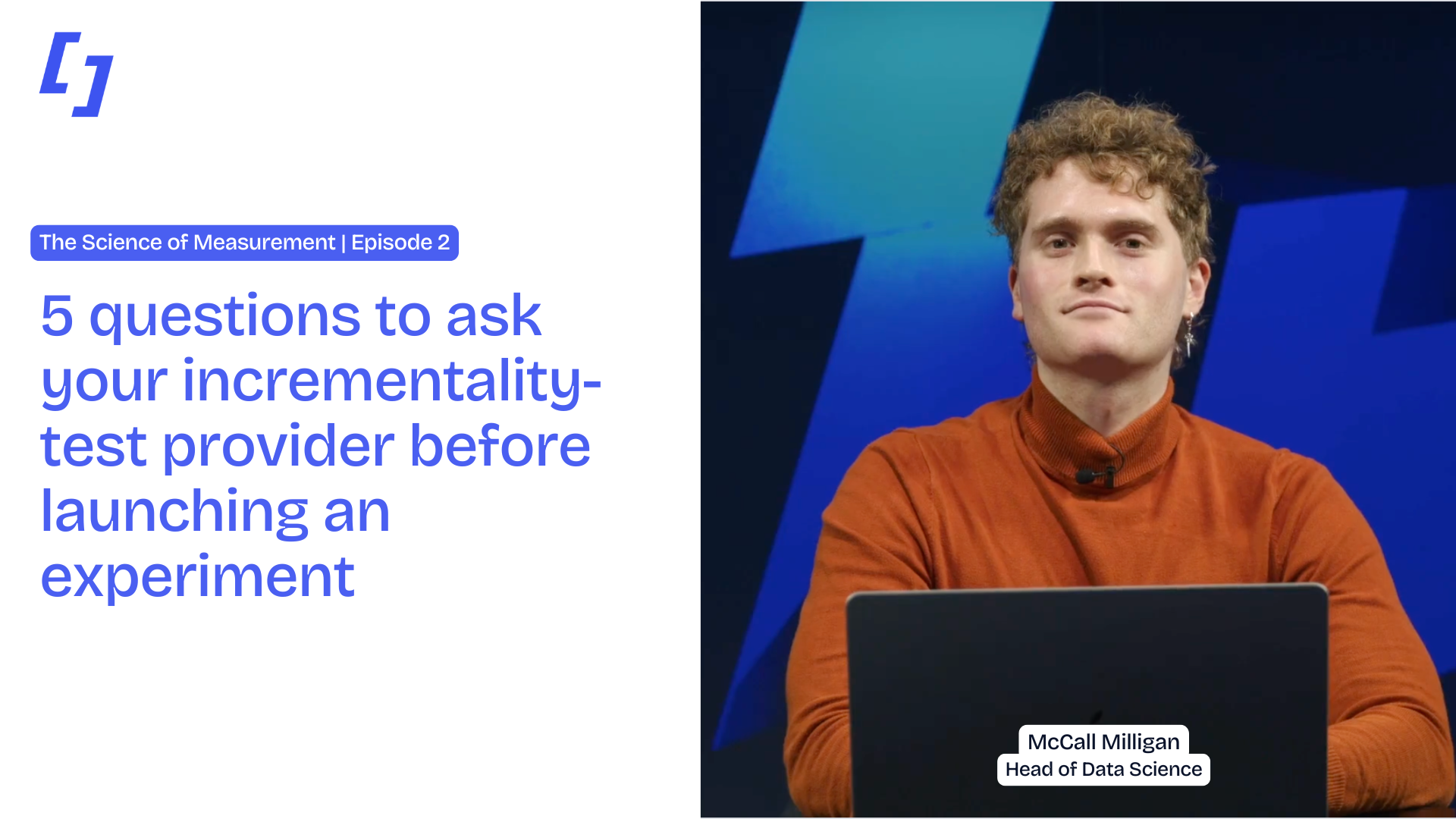Click vs. Impression Measurement: What’s the Real Difference and Which Should You Trust?
In modern marketing measurement, clicks tell only part of the story. This blog explains the difference between click and impression measurement, how clicks capture intent while impressions reveal influence, and why both are essential for understanding true campaign performance. Explore how unifying these signals through media mix modeling gives marketers a clearer, more reliable view of full-funnel impact.
.png)
The measurement crossroads
Modern marketing operates in a new reality. Customer journeys are increasingly fragmented across more channels, and privacy changes have reduced the signals marketers can track. At the same time, the rise of AI, from search overviews to automated bidding, is changing how people engage with ads, often reducing direct click interactions.
Yet many teams still anchor decisions on click-based measurement because it feels tangible, immediate, and familiar.
But clicks tell only part of the story. They show intent, but often miss influence.
In this piece, we unpack the difference between click and impression measurement, why both matter, and how Fospha’s ensemble approach brings them together to give marketers dependable, daily, full-funnel clarity.
Why the problem matters
Click-based attribution has been the default for years, for understandable reasons. Google Search was one of the first paid ad products marketers adopted, and Google Analytics was built to measure performance through the same lens: clicks leading directly to conversions.
When paid social emerged through platforms like Facebook, it was evaluated through that same framework. Over time, most brands became structurally reliant on last-click attribution, because it was the foundation the industry was built on.
Where last click works
Last Click still has value when used in the right context. It provides a fast, deterministic view of performance and is particularly useful for evaluating bottom-of-funnel efficiency, for example, when optimizing search, shopping, or retargeting campaigns where user intent is already high.
In these cases, it offers a reliable measure of how effectively a brand captures existing demand.
Where it falls short
The limitation arises when last click becomes the only lens through which performance is judged. Click measurement reflects the final mile of conversion, what happened right before the sale. It’s useful for diagnosing efficiency but inherently biased toward capture channels such as search, retargeting, or shopping ads.
Upper-funnel, demand-creating media - the Meta video that sparked curiosity, the TikTok ad that drove a brand search - often go uncredited, even though they built the demand that made the click possible.
Analyses across Fospha’s customer base, consistent with industry studies showing that Last Click models undervalue paid channels by more than 90% on average, indicate that awareness and discovery media are significantly more influential than click-based reports suggest.
That missing value doesn’t vanish; it simply gets reassigned to whichever channel captured the final click.
Signal loss and the illusion of precision
The growing privacy gap compounds this bias. Since iOS14, third-party cookies and pixels capture fewer events. What appears to be precise “click-path data” is often a partial record of what tracking allows us to see, not the full customer journey.
Click-based reports still feel concrete, but they now represent only part of performance - a visible fragment of the journey rather than the whole picture.
The business consequence
For performance and eCommerce teams, this matters every day. Over-reliance on click data can lead to under-investment in awareness and creative, over-allocation to lower-funnel channels, and slower growth over time.
Click-based measurement helps maintain efficiency, but it can under-represent the broader drivers of effectiveness.
What clicks measure vs. what impressions measure
Clicks = direct intent measured
Click-based models - whether last click, Data-Driven Attribution (DDA), or Multi-Touch Attribution (MTA) - measure observable user actions: who clicked, when, and on what. They’re excellent for revealing:
- Channel and campaign efficiency
- Lower-funnel conversion rates
- Tactical optimization opportunities
But clicks describe intent, not influence. They don’t account for the exposures that create that intent - the ad seen days before, the content that prompted a later search, or the brand encounter that shaped perception.
Clicks tell you who acted. They don’t tell you what drove that action.
Impressions = exposure, awareness & halo effects
Impression-based measurement focuses on exposure: who saw an ad and how that exposure relates to total conversions over time, even when no click occurred.
Rather than tracing user paths, it uses aggregated data to estimate how ad exposure influences sales - accounting for lag, seasonality, and cross-channel effects.
Impression measurement helps reveal:
- The contribution of awareness and discovery channels
- Halo effects across destinations (e.g., Meta ads driving Amazon sales)
- The long-term value of creative and brand activity
It’s model-based rather than deterministic, meaning results are inferred from aggregated data patterns rather than direct user actions.
Why neither alone gives the full story
Clicks measure capture. Impressions measure creation. Each reveals truth, but not the whole picture.
Imagine a customer sees a TikTok video, doesn’t click, but searches for the brand two days later and buys. Click data credits search. Impression data captures TikTok’s influence. Only by combining both can marketers see the true path from consideration to conversion.
Leaning solely on clicks biases spend toward short-term capture; relying only on impressions risks losing operational feedback. A unified, evidence-based view reconciles the two giving marketers dependable insight across the full funnel.
Fospha’s ensemble approach
At Fospha, we don’t believe marketers should choose between click or impression measurement. Both describe valuable, different aspects of performance, and both are essential.
Our model unifies them through a Bayesian Media Mix Model (MMM), designed for modern eCommerce brands that need daily accuracy and cross-channel comparability.
How it works
1. Click Ensemble (Lower Funnel): We start with click-based data from GA4, paid channels, and organic sources. Multiple model types are run in parallel using a “wisdom of the crowds” approach to generate a balanced, probabilistic estimate of lower-funnel performance.
2. Reconciliation to Truth: Results are aligned to reconciled eCommerce sources of truth such as Shopify and Magento. Any tracking gaps are accounted for within model bounds, ensuring outputs align closely with observed business performance.
3. Impression Modeling (Upper Funnel): Impression and engagement data from Meta, TikTok, YouTube, and other upper-funnel channels are layered to estimate their incremental and halo effects, including across marketplaces such as Amazon and TikTok Shop.
4. Daily Retraining and Validation: The model updates daily to reflect new media data and evolving channel mixes, balancing adaptability with statistical discipline. Results are benchmarked against incrementality tests and platform signals to validate directional accuracy.
5. Redistribution to Ad Level: The MMM is designed to provide cross-publisher, full-funnel measurement, modeling down to the campaign type and objective level for every platform in every market. Publishers have the strongest view of engagement within their ecosystems, so we use those intra-platform signals to redistribute MMM insights down to the ad level, combining the most appropriate data at each level of granularity for the specific jobs marketers need to solve.
The result is a unified, modelled view of marketing impact across clicks and impressions - a consistent, validated frame of reference for planning, optimization, and budget confidence.
When to lean on each signal
Each signal serves a distinct purpose. Knowing when to use each makes measurement both faster and smarter.
Short-Term Tactics
Best for: Tactical optimization, audience testing, creative iteration.
Use when: You need immediate feedback loops to refine lower-funnel efficiency.
Impression-Based Modeling
Best for: Understanding demand creation, evaluating creative and awareness ROI.
Use when: Planning full-funnel budgets or measuring halo effects.
Unified Model (Fospha)
Best for: Cross-channel allocation and financial planning.
Use when: You need a reconciled, daily view that helps marketing and finance make aligned decisions.
In short: click data powers operations, impression data informs strategy, and unified data brings the business together.
Practical takeaways for marketers
1. Don’t judge awareness channels on click KPIs. Paid social, influencer, and video often create demand that appears later - measure them on incremental contribution.
2. Anchor planning using unified, daily models. Platform analytics remain valuable for tactical insight, but strategic decisions benefit from reconciled, modelled data.
3. Anchor internal narratives around both capture (click) and creation (impression) signals.
4. Clicks show the last mile. Impressions show the demand created. Fospha unifies both, daily.
5. Design dashboards that reflect both signals. Integrate awareness and conversion metrics to prevent siloed reporting.
6. Expect and embrace uncertainty. Measurement is probabilistic by nature; Fospha’s daily retraining helps keep models aligned with real-world outcomes.
Seeing the whole picture
Click measurement tells you who bought. Impression measurement tells you why they bought.
Both matter, and both are needed to see performance clearly.
Brands that rely solely on clicks risk optimizing for the visible tail end of demand. Those that unify clicks and impressions gain a continuous, evidence-based view of how marketing creates and captures growth.
Measurement continues to evolve as signals and platforms change. Fospha’s goal is to make that evolution usable every day - combining the precision of clicks with the perspective of impressions, so marketers can plan and spend with confidence.
On average, brands using Fospha report up to 30% higher ROAS than market benchmarks, based on independent Varos data.
Stay ahead with the inside scoop from Fospha.
For over 10 years we've been leading the change in marketing measurement.





